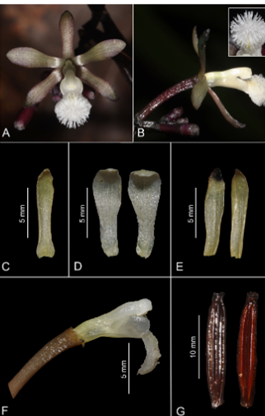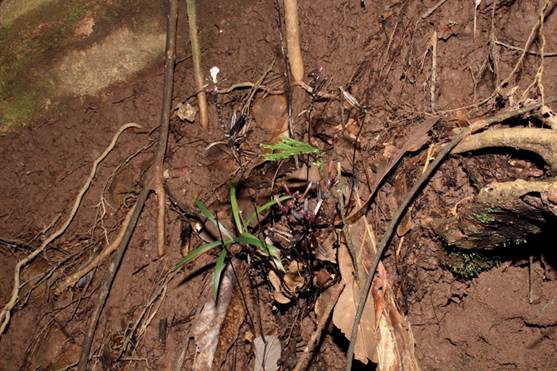Introduction
Lecanorchis Blume (Vanilleae), is a group of mycoheterotrophic orchid plants represented by approximately 30 species and varieties distributed in tropical Asia, including India, Thailand, Laos, Vietnam, Malaysia, China, Taiwan, Japan, the Philippines, Indonesia, New Guinea and the Pacific Islands (Hashimoto 1990, Pearce & Cribb 1999, Suetsugu et al. 2018a, Truong et al. 2020). Members of the genus can be easily recognized by leafless, achlorophyllous plant and the presence of a calyculus, a cup-like structure located between the base of the perianth and the apex of the ovary (Hashimoto 1990). In the Philippines, the genus is represented by three species (Pelser et al. 2011). Fresh materials of an unknown Lecanorchis plant were collected in Mt. Timolan Protected Landscape (MTPL) of Zamboanga del Sur province, the island of Mindanao in January 2022 as part of the author’s exploratory and conservation work on Orchidaceae. After meticulously examining its vegetative and reproductive morphology and comparison with protologues and relevant literature as well as digitized type specimens of the genus Lecanorchis, a match was made with Lecanorchis multiflora J.J.Smith.
Lecanorchis multiflora was described by Johannes Jacobus Smith based on specimens collected in Java, Indonesia (Smith 1918). Since then, the species has been recognized to occur only in Brunei, China, Indonesia (Java, Kalimantan, Maluku), Malaysia, and Thailand (GBIF 2022, POWO 2022). Although reported to occur in the Philippines (Pelser et al. 2011), the record is based on photos only. Therefore it is not clear whether the species was correctly identified. According to Suetsugu et al. (2018a, b), having a voucher specimen is necessary for us to precisely identify Lecanorchis taxa, which is often hindered by the similar morphology and brief flowering periods. As part of our effort to improve our understanding of the family Orchidaceae in the Philippines, we here present a description of L. multiflora based on our recently collected specimen, coloured photographs to aid identification, as well as information on distribution, habitat, phenology and conservation status.
Materials and methods
The measurements and description are based on the newly collected fresh material, and the voucher specimen was deposited at the Herbarium of the Northwestern University Luzon (HNUL). Multiple photographs were taken using Canon EOS 800D, and colour plates were prepared and edited in Affinity Photo software. The general plant descriptive terminology follows Beentje (2016). Relevant literature and type specimens of Lecanorchis species were examined in different herbaria through high-resolution images at JSTOR Global Plants accessed at https://plants.jstor.org/, and Global Biodiversity Information Facility (GBIF) accessed at https://www.gbif.org. The preliminary conservation status category was assessed following IUCN Standards and Petitions Subcommittee (2019) recommendations.
Taxonomic treatment
Lecanorchis multiflora J.J.Sm., Bull. Jard. Bot. Buitenzorg ser. II, xxvi. 8. 1918. SYNTYPES: INDONESIA. Java: Jawa Barat, Malang, Bantam, G.Malang, ?Am Z.O. van Pasaoeran, 400 m, March 1913, CA Backer 7158 (L [L0426579-image seen!, L0061477image seen!]; Buitenzorg, Goenoeng Karang Gantoengan, 900-1000 m, December 1912, CA Backer 6275 (not found); Ebenda, Goenoeng Gede bei Djasinga, 800-1000 m, November 1913, CA Backer 10124 (not found); Boerangrang am Nordhang, 1000-1200 m, June 1914, CA Backer 14020 (not found). Fig. 1.
Terrestrial, holomycotrophic herbaceous plant, up to 25 cm tall, with fleshy rhizomes underground. Rhizome 3-4 mm in diameter, branched, with nodes, nodes with amplexicaul sheaths; sheaths membranous, margin toothed. Roots simple, radiate numerous, horizontally or downward elongate to 20-30 cm long. Stem erect, slender, noded, nodes with sheaths; sheaths ovate to broadly ovate, 4-6 mm long, membranous, base amplexicaul. Inflorescence terminal, raceme, 8-10 cm long; floral bracts ovate, 2-3 mm long, membranous; rachis 4-6 cm long, glabrous, with 13-20 flowers. Flowers widely opening, 9-10 mm across, sepals and petals olive green suffused with dark purple, lip and column white with greenish base. Pedicel with ovary 10.0-12.5 mm long, 1.5-2.0 mm in diameter, cylindrical, sulcate, slightly curved, glabrous, pale claret. Dorsal sepal narrowly oblong, cucullate, 0.9-10.0 mm long by 1.5-2.0 mm wide, glabrous, margin entire, apex obtuse. Lateral sepals narrowly oblanceolate, cucullate, 9.0-9.5 mm long by 1.3-1.5 mm wide, glabrous, margin entire, apex obtuse. Petals spatulate, slightly cucullate, 8.0-9.5 mm long by 3.0-3.2 mm wide, glabrous, margin entire, apex obtuse. Lip 3-lobed, oblanceolate, slightly convex, 9-10 mm long by 3.0-4.5 mm wide; midlobe obovate, margin irregularly erose-denticulate, 5.0-5.5 mm long by 5.0-5.5 mm wide, covered with a dense mass of white hair, recurved; sidelobes obtusely elliptic, cucullate, 3-4 mm long by 2-3 mm wide, glabrous, margin entire, apex rounded. Column 7.0-7.5 cm long, 1.3-1.5 cm in diameter, glabrous, slightly curved, pale green at base, white at the apex. Capsule narrowly fusiform, 1.7-2.0 cm long, 3-4 mm in diameter, sulcate, glabrous, dark purple.
Distribution
In the Philippines, the species can only be confirmed in the provinces of Leyte on Visayas island and Zamboanga del Sur on Mindanao island (Fig. 2). Outside the Philippines, the species is found in Brunei, China, Indonesia (Java, Kalimantan, Maluku), Malaysia, Taiwan, and Thailand (GBIF 2022).
Habitat
The species was found growing in primary montane forest with a shaded and cool environment near the root of a tree at an elevation of 720 m, together with a Selaginella sp. and a young Arecaceae sp. (Fig. 2). In Java, the species can be found in moist forest at elevations between 400-1200 m asl (Comber 1990).
Phenology
In the Philippines, we found Lecanorchis multiflora flowering and fruiting in January and February. Based on herbarium records, the species flowers throughout the year (GBIF 2022), which agrees with the observations of Huang et al. (2019).
Preliminary conservation status in the Philippines
Endangered (EN). Mindanao embeds a diverse natural forest; however, the island is experiencing environmental pressures at present due to the expansion of oil palm and rubber plantations coupled with other anthropogenic threats such as wildlife hunting and poaching (Tanalgo 2017). Furthermore, although it is widespread across tropical Asia, the species was found to be quite rare, with less than ten mature individuals found in MTPL. Therefore, following the Red List Criteria of the IUCN Standards and Petitions Subcommittee (IUCN 2019), we proposed this species to be treated as ‘Endangered’.

A. Flower, front view.
B. Flower, lateral view (inset: detail of the labellum).
C. Dorsal sepal.
D. Petals.
E. Lateral sepals.
F. Pedicel with ovary, column and labellum, lateral view.
G. Fruit.
Photos by M. A. K. Naive.
Figure 1 Reproductive parts of Lecanorchis multiflora.
Specimen examined
PHILIPPINES. Mindanao: Zamboanga Peninsula, Zamboanga del Sur, Tigbao, Timolan, Mt. Timolan Protected Landscape, elev. 720 m, 29 January 2022, MAK Naive 126 (HNUL, spirit collection of flower).
The species is morphologically most similar to Lecanorchis trilobaJ.J.Smith (1908: 26) from New Guinea and the Bismarck Archipelago. Previous studies even noted that the morphological differences between L. multiflora and L. triloba remain unclear (e.g., Hashimoto 1990, Suetsugu et al. 2017). However, L. multiflora and L. triloba are usually accepted as the correct names (Suetsugu et al. 2019). Here, we also consider both as accepted names because almost all of the previous studies adopt the name L. multiflora for the widespread species in tropical Asia (Comber 1990, Suetsugu et al. 2018b). However, if they are conspecific, L. triloba should have priority over L. multiflora. A further study will be necessary to understand the taxonomical complexity between L. multiflora and L. triloba.












 uBio
uBio 



